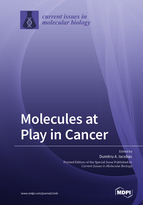Molecules at Play in Cancer
A special issue of Current Issues in Molecular Biology (ISSN 1467-3045). This special issue belongs to the section "Molecular Medicine".
Deadline for manuscript submissions: closed (31 December 2022) | Viewed by 75247
Special Issue Editor
Interests: cancer therapy; cancer biomarker; neurogenomics; systems biology; intercellular communication; neurotransmission
Special Issues, Collections and Topics in MDPI journals
Special Issue Information
Dear Colleagues,
Even with a wide range of incidence, cancer can occur in any part of the human body and spread to areas other than the originally affected organ. Decades of research and huge investments in developing diagnostic bioassays and therapeutic strategies are yet to produce valuable results for a better understanding of cancer formation and designing effective treatments. From genes to transcripts, proteins (enzymes included) and metabolites, a long list of molecular factors have been blamed for triggering the transformation of normal cells into cancer cells, many of them also being considered as actionable molecules for targeted therapies. However, combinations of cancer risk factors including race, sex, age, medical history, diet, habits and exposure to stress, toxins and radiation make each human dynamic and unique, questioning the meaning of cancer biomarkers and the feasibility of “fit-for-all” treatments. Tumor heterogeneity further complicates the characterization of cancer subtypes and requires complex approaches to destroy most of the primary cancer clones at once. Contributing papers to this Special Issue will present recent progress in the molecular diagnosis and targeted therapy of any type of cancer, with emphasis on how to better personalize the treatment to fit patient characteristics.
Dr. Dumitru A. Iacobas
Guest Editor
Manuscript Submission Information
Manuscripts should be submitted online at www.mdpi.com by registering and logging in to this website. Once you are registered, click here to go to the submission form. Manuscripts can be submitted until the deadline. All submissions that pass pre-check are peer-reviewed. Accepted papers will be published continuously in the journal (as soon as accepted) and will be listed together on the special issue website. Research articles, review articles as well as short communications are invited. For planned papers, a title and short abstract (about 100 words) can be sent to the Editorial Office for announcement on this website.
Submitted manuscripts should not have been published previously, nor be under consideration for publication elsewhere (except conference proceedings papers). All manuscripts are thoroughly refereed through a single-blind peer-review process. A guide for authors and other relevant information for submission of manuscripts is available on the Instructions for Authors page. Current Issues in Molecular Biology is an international peer-reviewed open access monthly journal published by MDPI.
Please visit the Instructions for Authors page before submitting a manuscript. The Article Processing Charge (APC) for publication in this open access journal is 2200 CHF (Swiss Francs). Submitted papers should be well formatted and use good English. Authors may use MDPI's English editing service prior to publication or during author revisions.
Keywords
- cancer biomarker
- cancer clone
- cancer functional pathway
- cancer gene therapy
- cancer master regulator
- cancer stem cell theory
- cancer targeted therapy
- cancer immunotherapy
- cancer personalized therapy







